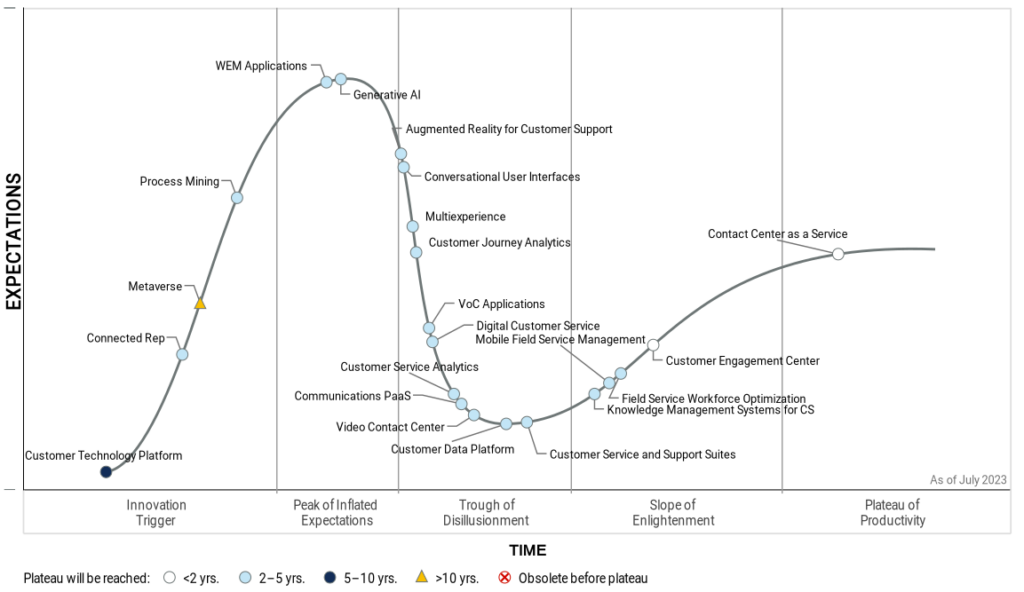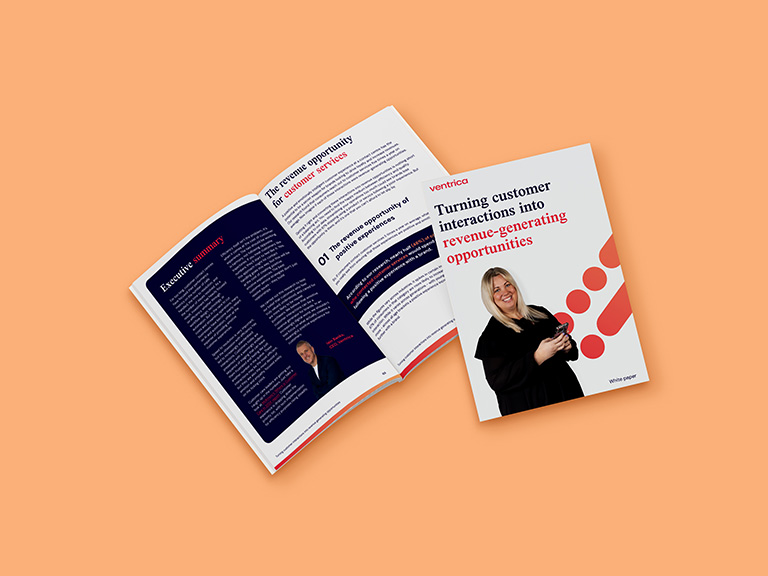What CX technology might look like in 10 years
Change often feels slow until we look back and reflect on its impact. As AI transforms customer experience, we stand at the brink of an exciting, unpredictable future.
- Insights, blogs & articles
“I’ve come up with a set of rules that describe our reactions to technologies:
1. Anything that is in the world when you’re born is normal and ordinary and is just a natural part of the way the world works.
2. Anything that’s invented between when you’re fifteen and thirty-five is new and exciting and revolutionary and you can probably get a career in it.
3. Anything invented after you’re thirty-five is against the natural order of things.”
Douglas Adams, The Salmon of Doubt
Change is a funny thing. It can appear to happen quite slowly while you’re in the middle of it. Only when you look back do you realise how different everything is.
If we look back ten years, most contact centre technology was still on-premises as the cloud was just getting started, we had only just begun to think in terms of Customer Experience and omnichannel and develop the technologies to deliver them, and chatbots were still a novelty with few practical applications.
Right now, however, change doesn’t feel like it’s happening slowly at all. All of us, no matter our age, are having to come to terms with the fact that we are entering the age of AI. Not in the “Terminator” sense, of course. AI is much more likely to be our partner and collaborator than our destroyer.
The sense of voyaging into the unknown is what’s getting people excited about this AI-driven wave of transformation – just like with the dotcom boom at the turn of the century and the mobile revolution a few years later. We can scarcely imagine what awaits us in the future.
But let’s try.
Digital customer service and generative AI
The digital revolution has been in full swing for a while now, but with Generative AI in the shape of Chat GPT and its loquacious friends joining the party, things are about to go into overdrive. In its latest annual Hype Cycle report into emerging technologies, Gartner identified three main trends impacting the near future of CX.
These are Generative AI (Chat GPT), Conversational User Interfaces (Alexa and other Virtual Assistants), and Digital Customer Service (AI-powered self-service). They can improve agent performance and productivity and transform how we deliver CX for customers.
Gartner’s lead analyst, Drew Kraus, expects 80% of customer service functions to have adopted Generative AI in some form by 2025. “The impact of AI on the customer service function cannot be overstated,” Kraus said. “Not only do we expect organisations to replace 20-30% of their agents with generative AI, but also anticipate it creating new jobs to implement such capabilities.”
Bold claims indeed, particularly as the technology still has some way to go. Gartner’s Hype Cycle (see below) shows it at the peak of inflated expectations, which means it will spend the next year or two sliding quickly down the trough of disillusionment before businesses and consumers truly come to grips with its potential.

It’s interesting to note that all the technologies on the Hype Cycle are expected to hit the plateau of productivity – when they become absorbed into the day-to-day mainstream – within five years, with the exceptions of the so-called Metaverse (a combination of Virtual Reality and Augmented Reality), and Customer Technology Platforms (which integrate customer data, CX solutions, customer contact channels, customer feedback, and CRM in a single platform). More on those later.
We’ll begin with technologies that will have a significant impact over the next two to five years.
Most organisations that operate contact centres or run CX programmes have already seen tremendous benefits from the digital transformation of the last 20 years. It has, however, not been without its challenges. Chief among these are preserving consistency across channels, training agents to adeptly handle multiple platforms, and maintaining data security.
Two to five years from now
We should also remember that the new technologies shaping CX, such as AI and Machine Learning, are not replacements for the human touch, which will always remain important in building customer relationships. With those caveats in mind, here are some of our predictions for the near future.
Unified Communications as a Service (UCaaS) platforms bundle voice, video, chat, and collaboration tools into a single cloud-based suite. Cloud solutions offer scalability and flexibility, enabling contact centres to deliver services to agent teams anywhere in the world, and dial resources up or down based on demand without physical infrastructure constraints.
Cloud communication platforms proliferate
With the hybrid and remote working trend showing few signs of slowing down and the difficulty of finding quality and reliable staff exactly when you need them (and then keeping them), cloud deployment is critical.
Cloud platforms also enable organisations to implement multimodal touchpoints and seamlessly integrate voice, chat, video, and AR/VR across different channels, offering customers a smooth and consistent experience.
IVR systems, chatbots, and customer portals embedded with AI are transforming self-service and enriching efficiency and satisfaction. ChatGPT and natural language processing allow for remarkably genuine conversations with chatbots. Structuring, improving, and tagging data is critical to training bots to emulate human interactions.
Chatbots keep improving
However, once you’ve done that, AI and Machine Learning allow chatbots to hyper-personalise interactions. Virtual assistants will evolve to provide highly customised experiences, predicting customer needs and proactively offering solutions. With sophisticated natural language processing and sentiment analysis, AI will become emotionally intelligent, understand how customers feel, and adjust communication accordingly, creating more empathetic interactions.
Even the Virtual Assistants we’ve had for a while, such as Siri and Alexa, are gaining conversational intelligence by adopting Generative AI and Large Language Models. Soon, we may enjoy seamless dialogue with virtual helpers for shopping, travel, planning, recommendations and web searches. As LLMs grow more sophisticated, so will the utility of AI assistants.
Tools like AI-powered FAQs and call-sorting algorithms assist staff in swiftly resolving issues. Sentiment tracking during calls and next-best-action prompts can provide agents with real-time guidance during customer interactions. AI gives agents an information advantage to drive efficient resolutions.
More agent assistance and automation
Robotic process automation (RPA) handles repetitive back-office tasks, freeing agents to focus on complex, empathy-intensive work. RPA bot building remains manual, but AI is beginning to automate bot creation and process design elements. Soon, AI may start coding itself.
The infusion of AI across customer self-service, virtual agents, human-assisted service and back-office automation constitutes a new era where manual efforts are augmented by intelligent technology. As AI capabilities expand, businesses can redirect human talent to higher-value work while better satisfying customer needs. The future of customer service lies in harmonious human-machine collaboration.
Augmented Reality (AR) and Virtual Reality (VR) customer service: AR will let customers visualise products and services in their environment, while VR can create immersive training simulations for agents or let customers virtually inspect complex products.
Immersive experiences through AR and VR
Businesses already use augmented reality (AR) and virtual reality (VR) to create immersive shopping and customer experiences across different sectors. AR enables virtual try-ons in retail stores, allowing shoppers to visualise outfits without setting foot in the store. VR provides lifelike property tours to real estate buyers from the comfort of their homes. By teleporting customers into hyper-realistic environments, these technologies spark new engagement dimensions.
AI will analyse customer data to predict service delays, recommend proactive interventions, and personalise support journeys.
Even more data-driven insights
AI will analyse customer data to predict service delays, recommend proactive interventions, and personalise support journeys.
Customer journey orchestration: By integrating data from various touchpoints, companies can understand the entire customer journey and personalise communications and experiences across all channels.
Real-time feedback loops: Continuous feedback through surveys, sentiment analysis, and social media monitoring will allow companies to adapt and improve customer experiences immediately.
Proactive service through IoT
The Internet of Things (IoT) is a web of sensors connected to the millions of devices distributed throughout our homes, workplaces, and neighbourhoods. Businesses can deliver a more proactive service model to their customers by analysing real-time product performance and usage monitoring. By tracking assets in the field, companies can get ahead of issues before they escalate, supercharging satisfaction. IoT lays the groundwork for customer service to evolve from reactive troubleshooting to preventative care.
Smarter teams working with AI
AI-powered advanced workforce engagement management (WEM) tools will be able to optimise team performance and efficiency to levels previously undreamt of. These systems encompass workforce optimisation and agent coaching to refine operations and enrich human-to-human customer exchanges.
The arrival of personal bots
A fascinating CX frontier is advanced personal bots. Imagine every customer having their own bot or virtual assistant to which they can give instructions. Rather than personally call or chat with a customer service agent, customers will simply ask their bot to liaise with the customer-facing bot of any company they do business with. These potentially completely autonomous interactions could see many billing, technical, and product-related inquiries handled with minimal human input on either side. While currently in the realm of speculative fiction, such a development would radically alter the whole customer service industry.
Streamlining service through computer vision
Ventrica already leverages computer vision to improve customer service and increase efficiency. Its application for tasks like document analysis and optical character recognition (OCR) could ease identity verification and help agents or case managers find information more quickly.
While still nascent, these breakthrough technologies will undoubtedly reshape CX just as much as the cloud, automation, and advanced analytics have in the last decade. As pioneer organisations like Ventrica continue to pilot new tools, we all edge closer toward the next era of customer engagement.
Five to ten years from now
In this next section, we will get a little more speculative. As we have seen, even Gartner only has two technologies on their Hype Cycle expected to come to productivity over a longer period than five years. Based on current trends and capabilities, we see the following potentially having a significant impact, while some are likely to remain science fiction:
Biometric authentication and personalisation: Facial recognition and voice analysis could simplify authentication and personalise experiences based on individual needs.
Blockchain-based customer data platforms: Secure and transparent data sharing through blockchain could empower customers and build trust.
Telepresence and holographic interactions: Agents could project themselves as holograms into customers’ homes, offering personalised service in a face-to-face setting regardless of physical location. This technology could evolve to a point where virtual customer service agents or representatives can be projected into a customer’s physical space, offering a blend of online convenience and face-to-face interaction.
Almost-sentient AI companions: Advanced chatbots become emotionally aware companions, guiding customers through journeys, understanding their needs beyond words, and providing comfort and empathy.
Customer journeys within virtual worlds: VR/AR experiences integrate with physical stores or online platforms, allowing customers to explore products and services in immersive digital environments with interactive avatars.
Personalised virtual assistants in a shared metaverse: Imagine a unified digital world where your personal AI assistant accompanies you across different platforms and virtual spaces, assisting you with purchases, recommendations, and social interactions.
The rise of AI-powered “citizen developers”: Customers become empowered to create and share customised customer experiences within the Metaverse, shaping brand interactions and offerings.
Autonomous service robots: Advanced robotics could lead to fully autonomous service robots in retail environments or public spaces, which would provide assistance, guidance, and even empathy in a more interactive and human-like manner.
Genetic personalisation: With advancements in genomics, businesses might offer services and products tailored to customers’ genetic profiles, leading to a new level of personalisation in health, wellness, nutrition, and even fashion industries.
Nanotechnology in product customisation: Nanotechnology could enable products that adapt to customer preferences in real time, like clothing that changes colour or shape based on the user’s mood or environmental conditions.
Direct Neural Interfaces (DNIs) for customer support: Imagine agents tapping into customers’ emotions and preferences directly through brain-computer interfaces, tailoring support in real-time based on subconscious needs and desires. Imagine using BCIs to communicate with customer service systems using thoughts directly. This could lead to hyper-personalised experiences, where customer needs are understood and addressed at the thought level, potentially as soon as the thought enters their head.
Biometric data for personalised sustainability goals: Customer data could be deployed helps optimise resource consumption and offers individuals sustainability challenges and rewards, creating a positive environmental impact.
AI-driven ethical sourcing and transparency: Blockchain technology tracks product origins and ensures ethical production practices, offering customers complete transparency and empowering responsible choices. There will likely be a greater emphasis on sustainability and ethics in customer experience management, with technologies and methodologies designed to minimise environmental impact and promote social responsibility.
Emotional AI for positive social impact: Sentient AI tools analyse customer sentiment and behaviour to detect societal issues like loneliness or mental health concerns, prompting targeted interventions and support networks. AI might evolve to recognise and interpret complex human emotions and respond appropriately. This could be used in customer service to provide highly empathetic and intuitive support.
Training and practice equip agents to handle complex situations with discretion and compassion. When customers face tricky issues or share sensitive information, a human’s reassuring voice can make all the difference in building trust and satisfaction. Machines may provide swift solutions, but authentic human connections create loyal relationships.
In complex or delicate scenarios, human agents can handle what automated systems cannot. Their ability to read between the lines and respond with discretion makes human insight irreplaceable.
The ideal approach blends empathetic humans and efficient technology as contact centres and CX continue to evolve. This pairing of AI’s consistency with humans’ discerning judgment and empathy will enable organisations to forge genuine connections with their customers at a cost they can bear.
While it might cost a little more, sometimes a customer needs to hear a caring voice.
The importance of the human touch
Though AI and automation will continue to advance and improve, chatbots still lack innate human traits like empathy, adaptability, and the ability to read emotional subtleties. While machines operate based on data, humans draw on lived experience to guide interactions.
Training and practice equip agents to handle complex situations with discretion and compassion. When customers face tricky issues or share sensitive information, a human’s reassuring voice can make all the difference in building trust and satisfaction. Machines may provide swift solutions, but authentic human connections create loyal relationships.
In complex or delicate scenarios, human agents can handle what automated systems cannot. Their ability to read between the lines and respond with discretion makes human insight irreplaceable.
The ideal approach blends empathetic humans and efficient technology as contact centres and CX continue to evolve. This pairing of AI’s consistency with humans’ discerning judgment and empathy will enable organisations to forge genuine connections with their customers at a cost they can bear.
While it might cost a little more, sometimes a customer needs to hear a caring voice.

Peter Edwards
CTO
